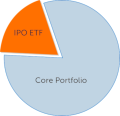While the "pop-and-drop" trend of 2022 has largely been put to rest, micro-cap IPO Sacks Parente Golf (SPGC) showed that it’s not gone entirely.
The California-based golf club maker raised just $13 million at a fully diluted market value of $63 million by pricing at the low end of the range, but ended Tuesday 624% above offer, the second-best debut for a domestic issuer in 20+ years. The stock opened lower on Wednesday and quickly shed the bulk of its gains, plummeting ~80% through midday.
Sign up for a free trial of IPO Pro, the platform that gives you all of the IPO information you need, all in one place.
The pop-and-drop phenomenon of 2022 saw a number of small US IPOs deliver explosive early trading, only to collapse in the aftermarket. China-based issuers primarily led the trend, in some cases creating artificially low floats by allocating large portions of shares to a small number of investors. As a result, US exchanges and regulators alike increased their scrutiny of these deals, chilling the pipeline of micro-cap listings.
Small IPOs have since returned in 2023, and so far, early trading has been less speculative. Prior to Sacks Parente, just two small Asia-based issuers (UCAR and MWG) had “pop-and-drop” patterns, a far cry from the 21 that rode the trend last year. Excluding the three outliers, the year’s sub-$20 million IPOs average a first-day return of -2%, and -27% from offer as of August 15.
While the US crackdowns primarily targeted foreign issuers, Sacks Parente serves as a reminder that small domestic companies can be just as susceptible to wild price swings. Concentrated allocations or not, low float stocks have become prime targets for momentum trading, to the benefit of some and the detriment of others.
SPACs are another common mark, as high redemptions can lead to very low floats. VinFast (VFS) is the latest example; its >90% redemption rate has led to volatile trading post-merger, with a 250%+ jump on the first day followed by a ~20% decline on day two, highly unusual for a company ostensibly valued above $50 billion. Aurora Acquisition (AURC) is another example, swinging up or down at least 20% on 7 days over the past month due to its high redemption rate and low float; some 250+ million shares of merger target Better are expected to become eligible for sale after the deal closes next week.


